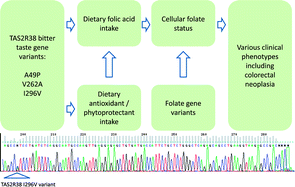Taste perception may influence dietary preferences and nutrient intakes contributing to diet-related disease susceptibility. This study examined bitter taste genetics and whether variation in the TAS2R38 gene at three polymorphic loci (A49P, V262A and I296V) could alter dietary and systemic folate levels and dietary vitamin C intake, and whether a nutrigenetic circuit existed that might link bitter taste, folate/antioxidant status and risk for a colonic adenomatous polyp. TAS2R38 diplotype predicted bitter taste (PROP) phenotype (p value <0.00001) and red cell folate status (p = 0.0179) consistent with the diplotype that has the broadest range of bitter perception (AVI/PAV) also possessing the highest average red cell folate value. However, TAS2R38 diplotype did not predict dietary intake of methylfolic acid, pteroylmonoglutamic acid or total folic acid. Neither did it predict dietary intake of vitamin C. Despite this, intake of dietary folate predicts red cell folate with analysis pointing to a key nutrient-nutrient interaction between vitamin C intake and systemic folate status. Analysis of 38 patients with an adenomatous polyp and 164 controls showed that individually, dietary nutrient intake, nutrient status and taste diplotype did not influence polyp risk. However, red cell folate status (in individuals below the population median value) did interact with bitter taste diplotype (AVI/PAV) to predict polyp risk (p = 0.0145). Furthermore, synthetic folic acid (below median intake) was statistically associated with adenoma occurrence (p = 0.0215); individuals with adenomatous polyps had a 1.77× higher intake than controls. Additionally, stepwise regression taking account of all dietary nutrients showed a tight relationship between methylfolic acid (but not pteroylmonoglutamic acid) intake and red cell folate level in those with a low folate status and occurrence of an adenomatous polyp (p = 0.0039). These findings point to a role for folate in the pathoaetiology of adenomatous polyps, with the natural and synthetic vitamers not necessarily having the same biological effect.

You have access to this article
 Please wait while we load your content...
Something went wrong. Try again?
Please wait while we load your content...
Something went wrong. Try again?


 Please wait while we load your content...
Please wait while we load your content...